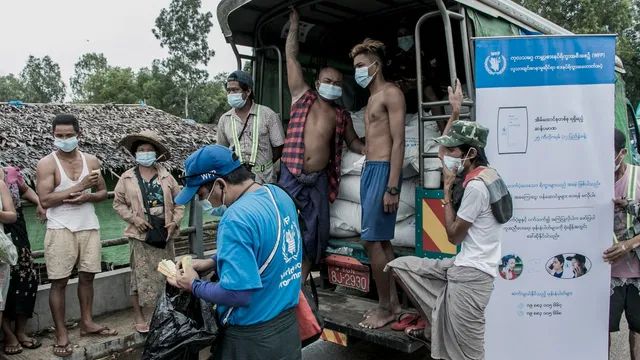
World Food Program cuts food aid for over 1 million people in Myanmar
2025-03-14 19:52- The World Food Programme is facing a critical funding shortfall, impacting their operations in Myanmar.
- Nearly 20 million people in Myanmar need humanitarian assistance due to escalating conflict.
- Cuts to food assistance will have devastating impacts on vulnerable communities reliant on aid.
Express your sentiment!
Insights
In Myanmar, over 1 million individuals are facing cuts to food assistance from the World Food Programme due to severe funding shortages. This crucial aid will cease in April 2025 amid escalating conflict and dire humanitarian conditions. Currently, nearly 20 million people in the country require humanitarian aid, with approximately 15.2 million facing acute food insecurity. The ongoing armed conflict, which began in February 2021 after the military ousted the elected government, has led to increased displacement and has contaminated agricultural lands, severely impacting local food production. The World Food Programme, a major humanitarian organization, has been unable to secure the $60 million needed to continue operations effectively in Myanmar. As a result, anticipated cuts will deeply affect various vulnerable populations, such as Rohingya communities and internally displaced persons. Furthermore, the ongoing violence has hindered access to necessary agricultural resources and workers, critically jeopardizing the capability to produce sufficient local food. Many who rely solely on the WFP for sustenance face even bleaker prospects amid the deteriorating situation. Despite these challenges, the WFP remains committed to providing support wherever possible, targeting the most vulnerable, including children under five, pregnant and breastfeeding women, and individuals living with disabilities. However, with funding increasingly scarce and already insufficient from previous years, the impacts of any further cuts are likely to be devastating. The conflict in Myanmar has created significant barriers for humanitarian organizations, with restrictions placed on information gathering and aid distribution by the military junta, complicating efforts and exacerbating the existing humanitarian crisis. As the country edges closer to the lean season between July and September, the urgency for more substantial funding becomes critical. The likely consequences of cuts to food assistance include worsening malnutrition rates and increased mortality rates, particularly among children and pregnant women. The WFP's leadership in Myanmar has been vocal about the implications of these financial difficulties, reiterating the importance of immediate support to prevent the loss of life and further deterioration of the humanitarian landscape in the region.
Contexts
The current situation of conflict in Myanmar remains deeply concerning as the country grapples with ongoing violence, political instability, and humanitarian crises. Following the military coup on February 1, 2021, which deposed the elected government led by Aung San Suu Kyi, the country has witnessed widespread civil unrest and resistance against the junta's rule. Armed groups, including ethnic militia and newly formed resistance forces, have engaged in confrontations with the military, leading to significant casualties and displacement among the civilian population. The fierce resistance has prompted the military to intensify its crackdown, escalating human rights abuses including arbitrary detentions, torture, and extrajudicial killings. This cycle of violence has profoundly destabilized Myanmar and has created a pervasive environment of fear and insecurity for many of its citizens. There has also been a severe humanitarian impact resulting from the conflict. An estimated 1.5 million people have been displaced internally due to the ongoing fighting with many fleeing into neighboring countries. Access to essential services such as healthcare, food, clean water, and education has been severely restricted, particularly in conflict-affected areas. International humanitarian organizations have faced challenges in delivering relief aid due to both the military's obstruction and ongoing violence. The United Nations has reported that the situation in Myanmar is one of the most pressing humanitarian crises globally, with millions in need of assistance. The COVID-19 pandemic has further exacerbated these vulnerabilities, with health systems already strained and facing significant disruptions. International responses to the conflict in Myanmar have been varied yet largely ineffective in altering the course of events on the ground. Many countries have condemned the coup and the violence perpetrated by the military, imposing sanctions aimed at specific military and government leaders. However, these measures have had limited impact on changing the military's behavior or in promoting a return to democratic governance. Regional players have sought to mediate the situation through dialogue, but progress remains minimal amid ongoing hostilities. The Association of Southeast Asian Nations (ASEAN) has initiated discussions and proposed a five-point consensus aimed at achieving peace and stability, yet the efficacy of these efforts has been questioned, particularly as the situation continues to deteriorate. In conclusion, the ongoing conflict in Myanmar is characterized by a complex interplay of political strife, civil resistance, and humanitarian crises. As the military junta struggles to maintain control amidst growing public discontent and armed opposition, the future of Myanmar remains uncertain. The lack of meaningful international intervention and the stagnant peace dialogues highlight the urgent need for a concerted global effort to address the crisis. Without a fundamental change in the dynamics of power and a commitment to addressing the humanitarian needs, the situation in Myanmar is likely to persist, leading to further suffering for its people.